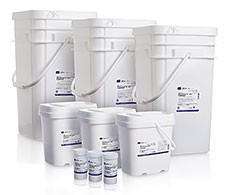 with Serena Fries Smith (Thermo Fisher Scientific)
with Serena Fries Smith (Thermo Fisher Scientific)
In the early 2000s, maximizing expression titers was the industry’s biggest challenge. Over the past 10–15 years, significant advances in media and feeds have enabled standard fed-batch processes to achieve 3 g/L, some as high as 7 g/L. The productivity increase is enabling scientists to move beyond titer and focus resources on addressing other scientific challenges (e.g., product quality modulation and process scale-up).
One way to address those challenges is by leveraging feed solutions to target specific protein quality attributes and simplify manufacturing. In a 1 October 2015 webinar, Serena Fries Smith explained how changes in feeding regimen and composition can enable companies to “dial in” specific glycosylation patterns. Her company has created superconcentrated feeds to maximize nutrient addition while minimizing bioreactors volume changes. Below is a summary of her presentation. You can find more detail and the full slide presentation online.
Smith’s Presentation
Thermo Fisher Scientific has tackled some industry challenges beyond maximizing protein titers. Our breakthrough feed formulations can modulate glycosylation, and through Advanced Granulation Technology (AGT) we have simplified handling of dry-format media and improved nutrient delivery for cells to aid in process scale-up.
Glycosylation: Tweaking this quality attribute to target a specific glycan distribution is critically important if you need to match a reported distribution for an existing product or target a specific glycan pattern to optimize the efficacy of a molecule. No single pattern is best for all products. By changing the concentrations of critical feed components and when they are introduced, users can adjust the glycosylation distribution of their clones to meet their specific product needs.
Feeding Strategy: Superconcentrated feeds can improve use of available bioreactor working volumes. A traditional fed-batch process may add ≥30% of a nutrient feed; a 3× concentration decreases that volume to <10% while delivering the same amount of nutrients. By reducing the volume added, you can increase your initial working volume. This minimizes volume change over time, resulting in less dilution of the product and more efficient bioreactor control.
Using an AGT format also can reduce errors. A typical two-part feed can have up to 16 process steps, including multiple pH/osmolality adjustments. A one-part dry-powder feed can still have up to 10 process steps, with similar adjustments. But AGT requires only six steps and no such adjustments. That reduces error and the need to manage additional raw materials. Additionally, Gibco Efficient Feed+ products are stable at room temperature for 30 days after reconstitution — eliminating the need for transport from cold rooms into production areas and reducing the frequency of feed preparation.
Before the question-and-answer session, Smith showed two example applications of EfficientFeed+ products. She then emphasized that these advances are available not only as catalogue products, but the technology also can be applied to custom solutions.
Questions and Answers
Q: How much development time would be needed to get a targeted glycan profile from an existing process?
A: You can do this as quickly as it takes to run a fed-batch experiment if you design that to evaluate multiple conditions. I recommend one screening experiment and a second experiment to optimize and finalize the chosen process. Assuming cells are available, you can complete an evaluation in under a month.
Q: Are the examples fed-batch or perfusion applications?
A: These products were developed primarily for fed-batch applications, but some customers have successfully used them in perfusion processes.
Q: Are these examples based on customer data?
A: These are in-house data.
Q: Do you have concentrated EfficientFeed+ products in liquid form?
A: Currently, they are available only in AGT format, so you can concentrate them as you need them. If you’re only able to work with liquid products, we can look at a custom product.
Q: Will glycan modulation work with other cell lines, such as NS0?
A: These products were developed primarily for CHO cells. Because other cell lines have different nutrient requirements, we can customize formulations to meet their needs.
Q: Is 3× the highest concentration feed you evaluated? Is special mixing equipment needed to make these higher concentration solutions?
 A: At 3×, you need no special mixing equipment. The AGT powder goes into solution quickly and easily. That is the highest concentration we’ve tested for room-temperature stability. You might be able to push it a little bit higher, but 3× would be our current recommended maximum.
A: At 3×, you need no special mixing equipment. The AGT powder goes into solution quickly and easily. That is the highest concentration we’ve tested for room-temperature stability. You might be able to push it a little bit higher, but 3× would be our current recommended maximum.
Check out the full webinar online at www.bioprocessintl.com/ThermoFisher-ATE-2015.
